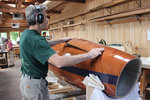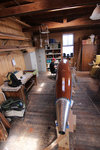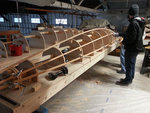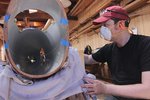A student on the University of Washington Human Powered Submarine Team had an idea: a wooden submarine – a beautiful wooden sub that could set a new world speed record at an international …
This item is available in full to subscribers.
We have recently launched a new and improved website. To continue reading, you will need to either log into your subscriber account, or purchase a new subscription.
If you had an active account on our previous website, then you have an account here. Simply reset your password to regain access to your account.
If you did not have an account on our previous website, but are a current print subscriber, click here to set up your website account.
Otherwise, click here to view your options for subscribing.
* Having trouble? Call our circulation department at 360-385-2900, or email our support.
Please log in to continue |
|




A student on the University of Washington Human Powered Submarine Team had an idea: a wooden submarine – a beautiful wooden sub that could set a new world speed record at an international race.
Through a collaboration between the UW team and Port Hadlock's Northwest School of Wooden Boatbuilding, a wooden sub is slated to make its racing debut in June 2017 at the International Human-powered Submarine Races in West Bethesda, Maryland.
“[The wooden sub] was a really cool opportunity for us to do something different,” said Connor Hughes, captain of the UW sub team.
Since 1989, the UW team has designed and built human-powered submarines for two biennial international races. Like most universities, the team has traditionally used carbon fiber and fiberglass as building materials.
Offered as an undergraduate design project through the UW’s Mechanical Engineering Department, the sub draws students from many engineering disciplines and other majors. Today’s team is composed of more than 40 students, who do everything from the design and racing of the sub to diving support.
Submerged in a pool, a pilot in scuba gear (the submarines are flooded for safety reasons) pedals his or her sub along a 175-meter course, trying to beat the clock and navigate slalom gates.
The UW team was one of 11 top collegiate teams in the world to qualify for the European International Submarine Races, which took place in July in Gosport, England. The UW team won third place all around and posted the top speed for a female pilot with its carbon fiber/fiberglass sub “What Sub Dawg.”
Judges awarded prizes for speed, design, construction and reliability, among other categories. The team from the University of Auckland in New Zealand captured all-around first prize with a submarine whose entire tail waved back and forth like a fish to make turns – innovative for human-powered subs, which are usually propeller-driven, said Bentley Altizer, former UW team captain and team member for four years. The sub team from the Delft University of Technology in the Netherlands beat the UW team by one-tenth of a point for second place.
A wooden submarine – demanding more innovation and knowledge than ever before – might be the next sub to beat, Altizer said.
A NEW PARTNERSHIP
Altizer had always admired a wooden sub hanging in the Applied Physics Library in Henderson Hall on the UW campus. Made of spruce in 1989, it was the team’s first sub and the only wooden one to date. He doesn't recall any team racing a wooden sub at a competition since the early 2000s, he said.
On the team's part, the engineering of the sub looked feasible, but the wood construction required a level of craftsmanship they didn't possess, he said.
“We were looking for a partner to build it and we wanted someone with experience to do it,” he said.
A referral from the Center for Wooden Boats in Seattle sent the team to the Northwest School of Wooden Boatbuilding (NWSWB), which quickly jumped on board with the proposal, commissioning the project and working it into the school’s Contemporary Wooden Boatbuilding curriculum.
Although the NWSWB has never made a wooden sub before, its students practiced the same techniques they would use to build any wooden boat, said Bruce Blatchley, the NWSWB instructor who supervised the project.
“Everyone, from the get-go, wanted to do the best they could, and it turned out to be a great learning tool,” Blatchley said.
The collaboration occurred in three phases. The UW team designed and built two halves of a plywood frame, delivering the submarine frame to the NWSWB in January 2016. NWSWB students cold-molded a hull from western red cedar and finished it in a khaya mahogany veneer. In August, the UW team took back the sub to outfit it for racing, which includes installing control and steering, a pedal propulsion system, and safety and life-support features.
One advantage of a wooden sub is that wood floats well, whereas a fiberglass sub needs foam as flotation material, Altizer said.
The wooden sub is the team’s first two-person craft, and both pilots would ideally be less than 5 feet 7 inches tall, he said. The sub is approximately 20 feet long, including a nose cone and about 3 feet in diameter at its widest section – not for the claustrophobic.
The wood is expected to perform as well as any material used for a submarine of this type; what really matters is the sub’s design, engineering and construction, Blatchley said.
“Everyone else that shows up is going to have high-tech carbon versions, and I think it will be a real blast to have that sub, in all its wooden glory, be the perfect vehicle for setting a world record,” he said.
FUTURE DIRECTION
“My stomach did a little backflip inside of me,” said Altizer, describing the first time he saw the constructed sub. As designers and engineers, the students were used to seeing the sub on a computer screen. Altizer graduated in June with a bachelor's degree in mechanical engineering and hopes to pursue a career in marine engineering.
“When we saw the care they were putting into the [wooden sub], it was pretty inspiring – just to see it and run your hands over it,” said Hughes, who is taking over as team captain this fall. “One of our main goals this year is to continue that level of craftsmanship in our own work.”
Armed with a technical secret they won’t share, team members are eager to improve the wooden sub before its first competition next summer, Hughes said.
“We're able to take high performance and engineering and marry it with the craftsmanship and tradition of wooden boatbuilding,” he said.
UW team members are set to publicly present the sub at the 40th annual Port Townsend Wooden Boat Festival on Friday, Sept. 9 and again on Sunday, Sept. 11; both presentations begin at 1:30 p.m.